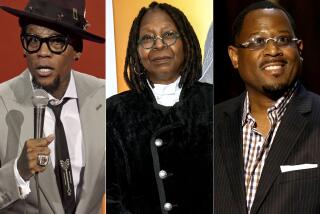NAACP Returns Its Focus to Matters of Public Policy
- Share via
PITTSBURGH, Pa. — After years of being diverted by internal scandals and power struggles, the National Assn. for the Advancement of Colored People served notice Monday that it hopes to reestablish its civil rights credentials with a younger generation by grappling more seriously with public policy issues.
“We are back,” NAACP President and Chief Executive Kweisi Mfume thundered in a keynote address that kicked off business sessions at the group’s annual convention in this city. “We need to get beyond blame, get beyond excuses and once again get back to doing for ourselves.”
Dr. Robert Deitchman, an official representing the Ohio delegation to the convention, was blunt and emphatic when asked if this year’s convention was different from recent ones.
“Hell, yes!” he said. “If you go back a couple of years, there was a lot of internal stuff. This year we’re talking about real stuff.”
He added that the estimated 3,000 people at the 88th annual convention welcome the chance to debate substantive matters, such as school desegregation and voucher programs, police brutality and job creation in inner cities.
“The return to issues is one of the best indications of the health of this organization,” he said.
Seeking to bolster the NAACP’s core mission and streamline its operations, Mfume said he was working with state and local officials to create a more centralized structure for the group. To that end, Mfume endorsed a series of constitutional changes that are expected to be contested by some members.
Among the more controversial are provisions to remove inactive or nonproductive branch officers, increase the dues structure and grant the national office, which is based in Baltimore, accounting oversight of branch and state chapter finances.
But regardless of how intense debates over these issues may get, it likely will pale when compared with previous fights at NAACP conventions. Three years ago, for example, NAACP leaders spent relatively little time addressing the organization’s traditional concerns as board members investigated allegations that former Executive Director Benjamin F. Chavis Jr. (now Benjamin Muhammad) used the group’s money to pay off a woman who had accused him of sexual harassment.
A year later, board members were embroiled in a battle between former Chairman William Gibson, a Chavis ally, and Myrlie Evers-Williams for control of the organization. Evers-Williams won the contentious fight to serve as head of the group’s board, a position she still holds.
At last year’s convention, Mfume was announced as the group’s president and chief executive, a new title created to persuade the former Democratic House member from Maryland to resign his seat in Congress to lead the NAACP.
“We’re down to business,” said Nelson Rivers, director of the Atlanta-based southeast region, the NAACP’s largest. “After going through what we’ve been through, we are now dealing with issues to get us where we are going.”
At times, however, evidence remains of the discord that marked the past gatherings.
On Sunday, in a keynote address that struck some angry chords, Evers-Williams cautioned members against unnamed “rats” who oppose the revitalization efforts that she and Mfume are leading.
*
“We have enough enemies outside [the NAACP] to deal with . . . as we move forward in this organization,” she said. “I have a dream, but I say I smell a rat.”
Evers-Williams urged NAACP members to stick to their principles of racial integration and to reject separatist arguments that would divide the organization. “The NAACP believes in an integrated society,” she said. “Like it or not, that is what our constitution says.”
In his remarks Monday, Mfume picked up on that theme. “Be aware of the snakes,” he said, referring to those opposed to the NAACP’s current direction.
Later, Mfume told reporters: “What we are talking about are forces . . . basically outside of this organization that are opposed to our progress.”
More to Read
Sign up for Essential California
The most important California stories and recommendations in your inbox every morning.
You may occasionally receive promotional content from the Los Angeles Times.













